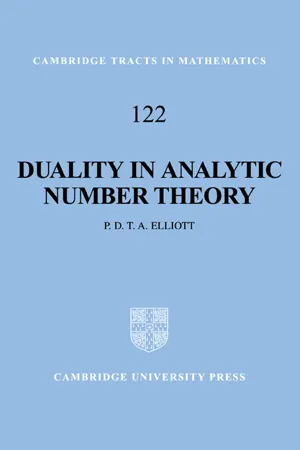
- English
- PDF
- Available on iOS & Android
Duality in Analytic Number Theory
About This Book
In this stimulating book, aimed at researchers both established and budding, Peter Elliott demonstrates a method and a motivating philosophy that combine to cohere a large part of analytic number theory, including the hitherto nebulous study of arithmetic functions. Besides its application, the book also illustrates a way of thinking mathematically: historical background is woven into the narrative, variant proofs illustrate obstructions, false steps and the development of insight, in a manner reminiscent of Euler. It is shown how to formulate theorems as well as how to construct their proofs. Elementary notions from functional analysis, Fourier analysis, functional equations and stability in mechanics are controlled by a geometric view and synthesized to provide an arithmetical analogue of classical harmonic analysis that is powerful enough to establish arithmetic propositions until now beyond reach. Connections with other branches of analysis are illustrated by over 250 exercises, structured in chains about individual topics.
Frequently asked questions
Information
Table of contents
- Cover
- Frontmatter
- Contents
- Acknowledgements
- Preface
- Notation
- Introduction
- Duality and Fourier analysis
- Background philosophy
- Operator norm inequalities
- Dual norm inequalities
- Exercises: Including the Large Sieve
- The method of the stable dual (1): Deriving the approximate functional equations
- The method of the stable dual (2): Solving the approximate functional equations
- Exercises: Almost linear, Almost exponential
- Additive functions of class ℒα. A first application of the method
- Multiplicative functions of the class ℒα: First Approach
- Multiplicative functions of the class ℒα: Second Approach
- Multiplicative functions of the class ℒα: Third Approach
- Exercises: Why the form?
- Theorems of Wirsing and Halász
- Again Wirsing's Theorem
- Exercises: The prime number theorem
- Finitely distributed additive functions
- Multiplicative functions of the class ℒα. Mean value zero
- Exercises: Including logarithmic weights
- Encounters with Ramanujan's function τ(n)
- The operator T on L 2
- The operator T on L α and other spaces
- Exercises: The operator D and differentiation. The operator T and the convergence of measures
- Pause: Towards the discrete derivative
- Exercises: Multiplicative functions on arithmetic progressions. Wiener phenomenon
- Fractional power Large Sieves. Operators involving primes
- Exercises: Probability seen from number theory
- Additive functions on arithmetic progressions: Small moduli
- Additive functions on arithmetic progressions: Large moduli
- Exercises: Maximal inequalities
- Shift operators and orthogonal duals
- Differences of additive functions. Local inequalities
- Linear forms in shifted additive functions
- Exercises: Stability. Correlations of multiplicative functions
- Further readings
- Rückblick (after the manner of Johannes Brahms)
- References
- Author index
- Subject index